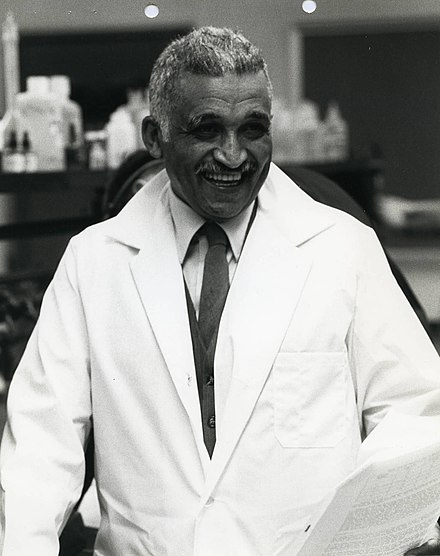Samuel Proctor Massie, Jr., was born in Argenta, AR, 3 July 1919, to Earlee Lillian Jacko Massie, a teacher, and her husband Samuel Proctor Massie, Sr., charter member of Phi Beta Sigma Fraternity and AME minister in North Little Rock, who also taught at Dunbar High School there.
Massie Jr graduated from Dunbar High School at the age of 13 after following his teacher mother from class to class, and then worked at a grocery store to earn tuition fees for studying at Dunbar Junior College in Little Rock. He graduated summa cum laude with a Bachelor of Science in Chemistry in 1937 at the age of 18, from the Arkansas Agricultural, Mechanical, and Normal College.
Massie gained a master’s degree in Chemistry from Fisk University in Tennessee in 1940 on a scholarship, then taught for a year at Arkansas AM&N before going on to study for his PhD at Iowa State University in 1941 and would later complete it in 1946.
In the second year of his doctoral studies in 1943, his father died from an asthma attack. Massie worked in the Ames Laboratory, researching the conversion of uranium isotopes into liquid compounds that could be used in the atomic bomb. He worked on the Manhattan Project from 1943 to 1945. In those intervening years you can read more about Massie’s work on the Manhattan Project from the Ames Research Laboratory.
In 1947, Massie married Gloria Bell Thompkins, who he met after the War when he was teaching at Fisk University. The Massies’ had three sons. They lived in Laurel, Maryland, when he joined the U.S. Naval Academy.
After completing his PhD and teaching for a time at Fisk University, Massie joined the faculty of Langston University in Oklahoma, where he taught from 1947 to 1953. He became the first African-American president of the Oklahoma Academy of Science. In 1953, he returned to Fisk University, where he taught until 1960. In 1954, he published a paper, The Chemistry of Phenothiazine.
In 1960, Massie moved to Washington, D.C., taking on the role of Associate Program Director for Special Projects in Science Education at the National Science Foundation, helping improve college laboratories nationwide. He was also a professor at Howard University. In 1963, he became the third President of North Carolina College at Durham.
Massie was appointed to the faculty of the United States Naval Academy by President Johnson in 1966, its first African-American professor. During his tenure in Annapolis, Massie served on the academy’s equal employment opportunity committee and helped establish a black studies program. He retired from the post in 1993. Massie subsequently became the vice president of Bingwa Software Company, developing multicultural educational software. In 1984, he and others were granted a patent for a chemical compound to treat gonorrhea, malaria, and bacterial infections. In 1994, the U.S. Department of Energy created the Dr. Samuel P. Massie Chair of Excellence, a $14.7 million grant to nine historically black colleges and one for Hispanic students to further environmental research. His portrait was hung in the National Academy of Sciences Gallery in 1995. In 1998, he was voted by the readers of Chemical and Engineering News as one of the top 75 distinguished contributors to chemistry in history.
His wife died on January 22, 2005, and Massie, who had dementia, died soon after, on April 10, 2005, aged 85. He also self-published a short autobiography with the collaboration of Robert C. Hayden in 2005.
Sources
Photo Credit: US Naval Academy(N.D.) Samuel P Massie in a lab. Wikimedia Commons. https://commons.wikimedia.org/wiki/File:Samuel_P_Massie_in_lab.jpg
“Ames Laboratory History Profile: Samuel P. Massie.” Ames Laboratory, 8 Feb. 2021, www.ameslab.gov/news/ames-laboratory-history-profile-samuel-p-massie.
“Samuel P. Massie.” Wikipedia, Wikimedia Foundation, 30 Jan. 2024, en.wikipedia.org/wiki/Samuel_P._Massie.
